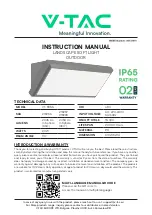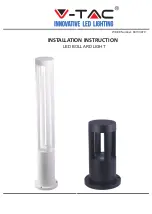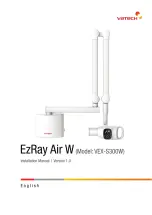
Welch Allyn arc lamps are designed for direct current
(DC) operation. It is vital that the lamp be installed and
maintained with the correct polarity. The supplied polarized
connectors, which electrically couple the arc lamp and
ballast, are designed to provide the proper voltage polarity.
The two insulated wires supplied with the connection
assemblies are colored-coded: the black wire is connected
to the cathode and the white wire is connected to the
anode of the arc lamp. Solder the anode lead (white wire)
of the lamp connector assembly to P1. Solder the cathode
lead (black wire) of the lamp connector assembly to P2.
Trim any excess material. The P1 and P2 output terminals
can be found at the top middle edge of the ballast
assemblies shown in Figures 1 and 2.
• Avoid connecting the P1 and P2 terminals to anything other
than the arc lamp. Instrumentation and/or other circuitry
connected to either one of these electrical nodes can drastically
affect normal ballast operating performance
• High-voltage pulses are present on the P1 terminal during ignition
• Failure to observe input power wiring polarity could result in
catastrophic failure of the product
Labeling
Proper labeling is important with any product, and the
S ¯olarc is no exception. Warnings reminding users that the
lamps can be hot and should be allowed to cool down
prior to replacement, and not to put anything, including
fingers, into the lamp socket, should be clearly marked in
the appropriate languages.
Cooling (10 W Systems)
Heat removal is important. The main heat transfer occurs
through the ballast. The ballast sides also provide the best
mechanical surface for heat conduction to occur. Although
plastic housings can be designed into your product, it is
best to have a solid metal-to-metal contact with the ballast
can. An air gap between the ballast and its mounting
surface should be avoided. If plastic is preferred, then
heat-transferring plastics such as 30% carbon-filled or
glass-filled material are best.
The most important measurement of a proper S ¯olarc lamp
and ballast installation is the temperature on the ballast
metal can. With a thermocouple attached half way up the
side of the ballast, you can measure the heat conduction
of the system. It’s important to keep the maximum case
temperature no greater than 90˚C.
Unusual increases in operating temperature can be caused
by a variety of factors:
• Nothing should be mounted directly to the back side of
the reflector
• An additional heat shield (commonly found on halogen
installations) will cause a significant rise in operating
temperatures within the assembly
• Any housing that immediately surrounds the lamp should be
black so as not to reflect stray light back into the lamp
• When an additional cover glass is used, make sure it is rated
for high transmission; otherwise reflected light energy from
the front can overheat the system
• Never use any plastic material as an outside barrier
• The common cause of high temperature is overvoltage
to the ballast. Make sure that you have the correct ballast for
the particular battery type and configuration
When designing the enclosure, consider the fact that
your product may not always be running in an ideal
laboratory environment. The 90˚C maximum temperature
should take into account typical operating temperatures
the product will experience in actual use, as well as any
extreme conditions it might encounter.
Cooling (18 W – 60 W Systems)
The maintenance of adequate cooling is another critical
consideration in lamp life and arc stability. The lamp must
not exceed its operating temperature limits, which in most
cases requires that the lamp be forced air-cooled. Cooling
must be sufficient to maintain the temperature at the tip
of the arc tube generally between 200˚C and 285˚C.
In a few situations it may be possible to cool the lamp by
convection. In general however, the equipment designer
must be certain that the flow of air is adequate and cannot
be blocked. Conversely, it’s also important that the lamp
not operate overly cooled or it will experience instability,
inconsistent performance, an arc that is bluer in color and
may cause possible flickering.
The critical temperatures are at the seals of the arc tube
and at the molybdenum foils. If the temperature limits
at these points are exceeded, the seal between the foils
and the glass envelope may fail and create a leak, thus
shortening lamp life and causing erratic performance.
LAMP TEMPERATURE & COOLING
9



































